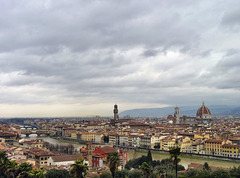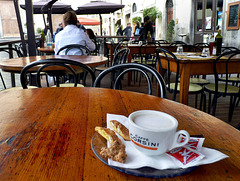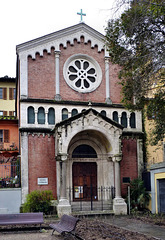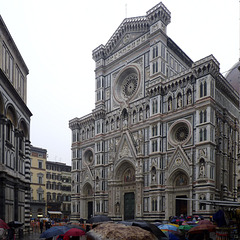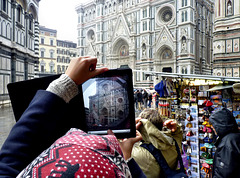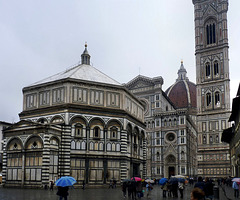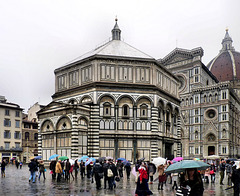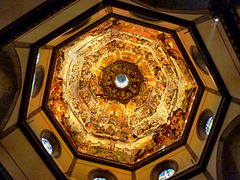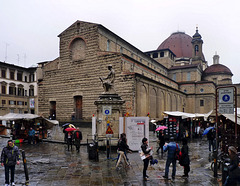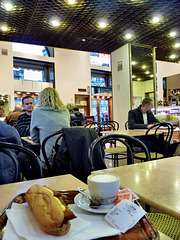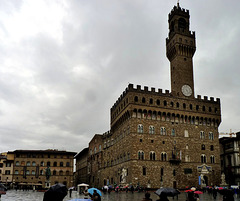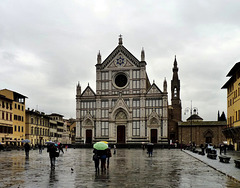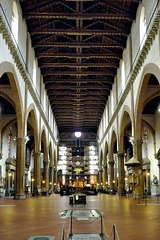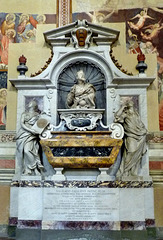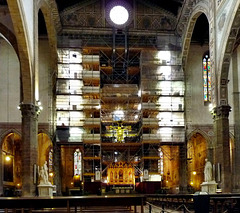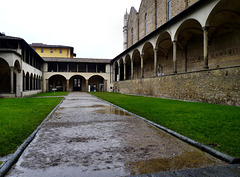
Siena / Florence
Florence
| |
|
|
Florentina was established in Roman times as a settlement for veteran soldiers. The name had changed already, when young Charlemagne conquered the town in 774. It became part of the Duchy of Tuscany, with Lucca as capital. Around 1000 Margrave Hugo chose Florence as residency instead of Lucca. After the death of Matilda of Tuscany (1115), the Florentines formed a republic was ruled by a council. The town prospered, despite a constant fight between the different factions and noble families.
In the 15th century, Florence was among the largest and wealthiest cities in Europe. This was, when the Medici family entered the political scene. As a dynasty of art loving, power hungry bankers, they made Florence the birthplace of the Renaissance.
The rain ceased for an hour and so I walked up a hill, to get an overview.
Seen here are the "Ponte Vecchio" crossing the Arno (left), the large tower (94m high!) belongs to the "Palazzo Vecchio", today the town hall of Florence.
The small dome belongs to the "Basilica di San Lorenzo", the white triangle is the roof of the "Battistero di San Giovanni", next to this with the campanile and the large dome is the "Cattedrale di Santa Maria del Fiore". The small church in front of the cathedral is the "Chiesa di Santa Margherita dei Cerchi"..
Florence - Cappuccino
| |
|
I had hoped for better weather, when I left Lucca, but there was no sunshine in Florence, when I arrived at the station. At least the rain was not pouring down, when I crossed the river Arno. I had a nice cappuccino under an umbrella, before I checked into the hotel.
Florence - Ponte Vecchio
| |
|
|
|
The Romans may have had a bridge here, spanning the Arno at its narrowest point. The "Via Cassia" crossed Florentia, a settlement founded 80 BC for veteran soldiers.
For sure a bridge existed in 996. This bridge got destroyed by a flood in 1117, rebuilt - and swept away again in 1333. It was rebuilt again in 1345. Shops existed on the bridge already in medieval times (like on many bridges in Europe), but then probably butchers offered their goods here. Meanwhile jewellery and souvenirs are offered to the thousands of tourists, using the Ponte Vecchio every day. Even during a very rainy day!
In 1944 the retreating German army destroyed all bridges in Florence - except the Ponte Vecchio!
Florence - Chiesa Luterana
| |
|
Not all churches in the city of Florence date back to the Middle Ages and Renaissance, some are comparably young. The lutheran parish exists in Florence since more than 100 years. It is one of the oldest lutheran parishes in Italy.
The inscription over the portal reads "Eine feste Burg ist unser Gott", one of the best known hymns by the reformer Martin Luther.
www.youtube.com/watch?v=pG0xARoDlZw
--
The parish has a website in Italian and German:
www.chiesaluterana-firenze.org/
Florence - Cattedrale di Santa Maria del Fiore
| |
|
Florentina was established in Roman times as a settlement for veteran soldiers. The name had changed already, when young Charlemagne conquered the town in 774. It became part of the Duchy of Tuscany, with Lucca as capital. Around 1000 Margrave Hugo chose Florence as residency instead of Lucca. After the death of Matilda of Tuscany (1115), the Florentines formed a republic was ruled by a council. The town prospered, despite a constant fight between the different factions and noble families.
In the 15th century, Florence was among the largest and wealthiest cities in Europe. This was, when the Medici family entered the political scene. As a dynasty of art loving, power hungry bankers, they made Florence the birthplace of the Renaissance.
The construction of the cathedral, designed by Arnolfo di Cambio, started in 1296, replacing an older cathedral, that was too small for the growing population. It was completed about 140 years later with a dome engineered by Filippo Brunelleschi and a campanile designed by Giotto.
The western facade of the basilica, seen here, dates to the 19th century and was done by Emilio De Fabris.
Florence - Cattedrale di Santa Maria del Fiore
| |
|
|
|
Florentina was established in Roman times as a settlement for veteran soldiers. The name had changed already, when young Charlemagne conquered the town in 774. It became part of the Duchy of Tuscany, with Lucca as capital. Around 1000 Margrave Hugo chose Florence as residency instead of Lucca. After the death of Matilda of Tuscany (1115), the Florentines formed a republic was ruled by a council. The town prospered, despite a constant fight between the different factions and noble families.
In the 15th century, Florence was among the largest and wealthiest cities in Europe. This was, when the Medici family entered the political scene. As a dynasty of art loving, power hungry bankers, they made Florence the birthplace of the Renaissance.
The construction of the cathedral, designed by Arnolfo di Cambio, started in 1296, replacing an older cathedral, that was too small for the growing population. It was completed about 140 years later with a dome engineered by Filippo Brunelleschi and a campanile designed by Giotto.
The western facade of the basilica dates to the 19th century and was done by Emilio De Fabris.
As the weather got worse, I needed the support of other tourists, to take shots.
Florence - Battistero di San Giovanni
| |
|
Florentina was established in Roman times as a settlement for veteran soldiers. The name had changed already, when young Charlemagne conquered the town in 774. It became part of the Duchy of Tuscany, with Lucca as capital. Around 1000 Margrave Hugo chose Florence as residency instead of Lucca. After the death of Matilda of Tuscany (1115), the Florentines formed a republic was ruled by a council. The town prospered, despite a constant fight between the different factions and noble families.
In the 15th century, Florence was among the largest and wealthiest cities in Europe. This was, when the Medici family entered the political scene. As a dynasty of art loving, power hungry bankers, they made Florence the birthplace of the Renaissance.
A baptistry existed here already within the fifth century. It was replaced or altered in the sixth century.
Today´s octagonal "Baptistery of Saint John" was constructed between 1059 and 1128, making it one of the oldest buildings in Florence. It was reconsecrated in 1059 by Pope Nicholas II. The octagonal lantern was added to the pavilion roof around 1150. The baptistery was enlarged with a rectangular apse on the west side in 1202.
Just "behind" the Baptistery is the "Duomo di Firenze" with the Giotto-campanile und the Brunelleschi-dome.
Florence - Battistero di San Giovanni
| |
|
|
|
Florentina was established in Roman times as a settlement for veteran soldiers. The name had changed already, when young Charlemagne conquered the town in 774. It became part of the Duchy of Tuscany, with Lucca as capital. Around 1000 Margrave Hugo chose Florence as residency instead of Lucca. After the death of Matilda of Tuscany (1115), the Florentines formed a republic was ruled by a council. The town prospered, despite a constant fight between the different factions and noble families.
In the 15th century, Florence was among the largest and wealthiest cities in Europe. This was, when the Medici family entered the political scene. As a dynasty of art loving, power hungry bankers, they made Florence the birthplace of the Renaissance.
A baptistry existed here already within the fifth century. It was replaced or altered in the sixth century.
Today´s octagonal "Baptistery of Saint John" was constructed between 1059 and 1128, making it one of the oldest buildings in Florence. It was reconsecrated in 1059 by Pope Nicholas II. The octagonal lantern was added to the pavilion roof around 1150. The baptistery was enlarged with a rectangular apse on the west side in 1202.
Just behind the Baptistery is the "Duomo di Firenze" with the 19th century facade and the Brunelleschi-dome.
Florence - Cattedrale di Santa Maria del Fiore
| |
|
Florentina was established in Roman times as a settlement for veteran soldiers. The name had changed already, when young Charlemagne conquered the town in 774. It became part of the Duchy of Tuscany, with Lucca as capital. Around 1000 Margrave Hugo chose Florence as residency instead of Lucca. After the death of Matilda of Tuscany (1115), the Florentines formed a republic was ruled by a council. The town prospered, despite a constant fight between the different factions and noble families.
In the 15th century, Florence was among the largest and wealthiest cities in Europe. This was, when the Medici family entered the political scene. As a dynasty of art loving, power hungry bankers, they made Florence the birthplace of the Renaissance.
The construction of the cathedral, designed by Arnolfo di Cambio, started in 1296, replacing an older cathedral, that was too small for the growing population. It was completed about 140 years later with a dome engineered by Filippo Brunelleschi.
Looking up into the dome, that was largest dome in the world for a long time.
Florence - Basilica di San Lorenzo
| |
|
|
|
Florentina was established in Roman times as a settlement for veteran soldiers. The name had changed already, when young Charlemagne conquered the town in 774. It became part of the Duchy of Tuscany, with Lucca as capital. Around 1000 Margrave Hugo chose Florence as residency instead of Lucca. After the death of Matilda of Tuscany (1115), the Florentines formed a republic was ruled by a council. The town prospered, despite a constant fight between the different factions and noble families.
In the 15th century, Florence was among the largest and wealthiest cities in Europe. This was, when the Medici family entered the political scene. As a dynasty of art loving, power hungry bankers, they made Florence the birthplace of the Renaissance.
In 1419 Giovanni di Bicci de' Medici offered to finance a new church to replace the 11th-century Romanesque Basilica of San Lorenzo. Filippo Brunelleschi was commissioned to design it. When Brunelleschi died in 1446 only the sacristy and the crossing were completed. His scholars continued, but changed the design. As San Lorenzo was the parish church of the Medici family (and their burial place) Pope Leo X (born "Giovanni di Lorenzo de' Medici") commissioned Michelangelo to design a façade in 1518.
Michelangelo made a wooden model, that still exists, but this facade, as you can see here, was never added to the church.
Florence - Cafeteria
| |
|
Meanwhile I was soaked. The rain continued. I found a cafeteria near the the Baptistery, where it was warm and dry. I stayed inside for an hour and had lunch.
Florence - Palazzo Vecchio
| |
|
Florentina was established in Roman times as a settlement for veteran soldiers. The name had changed already, when young Charlemagne conquered the town in 774. It became part of the Duchy of Tuscany, with Lucca as capital. Around 1000 Margrave Hugo chose Florence as residency instead of Lucca. After the death of Matilda of Tuscany (1115), the Florentines formed a republic was ruled by a council. The town prospered, despite a constant fight between the different factions and noble families.
In the 15th century, Florence was among the largest and wealthiest cities in Europe. This was, when the Medici family entered the political scene. As a dynasty of art loving, power hungry bankers, they made Florence the birthplace of the Renaissance.
The Palazzo Vecchio overlooks the Piazza della Signoria. Originally the building was called "Palazzo della Signoria", as here the nine elected member of the Signora the government of Florence lived during their term. The building started in 1299, some years after the guilds had taken over the politcal power, as only guild members were electable into the goverment.
The Piazza della Signoria was the place, where in February 1497 "Falò delle vanità" (bonfire of vanity") burnt. The fire destroyed thousands of objects of vanity, art and immorality such as books, paintings, fine dressings, playing cards, mirrors, sculptures and musical instruments. This fire had been organized by the friar Girolamo Savonarola, a charismatic preacher of an early "Cultural Revolution". His young followers, named "fanciulli" have very much in common with the Mao Zedong´s Red Guards.
Actually for about four years Savonarola and the fanciulli "ruled" Florence.
In May 1497 Pope Alexander VI excommunicated Savonarola. The local support for him dwindled, when his enemies (and rain) hampered an ordeal by fire. He was imprisoned and got tortured in the tower of the Palazzo Vecchio.
On May 23 1498 he and two confrères were sentenced to death and in front of a large crowd were hanged on this Piazza. Under the gallows fires were ignited to consume the bodies. The ashes of Girolamo Savonarola and his confrères Fra Domenico and Fra Silvestro were scattered in the Arno to prevent followers to collect relics.
There is a little plaque on the ground, where Girolamo Savonarola died. It is near the blue umbrella.
-
P.S.
The statue of Michelangelo´s "David" near the entrance of the Palazzo Vecchio is a replica. The original statue was removed from the piazza in 1873 and since then can be admired in the Accademia Gallery.
Florence - Basilica of Santa Croce
| |
|
|
Florentina was established in Roman times as a settlement for veteran soldiers. The name had changed already, when young Charlemagne conquered the town in 774. It became part of the Duchy of Tuscany, with Lucca as capital. Around 1000 Margrave Hugo chose Florence as residency instead of Lucca. After the death of Matilda of Tuscany (1115), the Florentines formed a republic was ruled by a council. The town prospered, despite a constant fight between the different factions and noble families.
In the 15th century, Florence was among the largest and wealthiest cities in Europe. This was, when the Medici family entered the political scene. As a dynasty of art loving, power hungry bankers, they made Florence the birthplace of the Renaissance.
The Basilica di Santa Croce is the principal Franciscan church in Florence and the largest Franciscan church worldwide.
Legends tell, that it was founded by St Francis himself, but proven is that the construction was begun outside the city walls in 1294. The floorplan is a Tau cross, what is a symbol of St Francis. The design was done by Arnolfo di Cambio, a very busy architect, as he worked as well at the Cattedrale di Santa Maria del Fiore and the Palazzo Vecchio. The church was consecrated in 1442 by Pope Eugene IV.
Florence - Basilica of Santa Croce
| |
|
Florentina was established in Roman times as a settlement for veteran soldiers. The name had changed already, when young Charlemagne conquered the town in 774. It became part of the Duchy of Tuscany, with Lucca as capital. Around 1000 Margrave Hugo chose Florence as residency instead of Lucca. After the death of Matilda of Tuscany (1115), the Florentines formed a republic was ruled by a council. The town prospered, despite a constant fight between the different factions and noble families.
In the 15th century, Florence was among the largest and wealthiest cities in Europe. This was, when the Medici family entered the political scene. As a dynasty of art loving, power hungry bankers, they made Florence the birthplace of the Renaissance.
The Basilica di Santa Croce is the principal Franciscan church in Florence and the largest Franciscan church worldwide. The nave, seen (partially) here is 115 ms long.
Legends tell, that it was founded by St Francis himself, but proven is that the construction was begun outside the city walls in 1294. The floorplan is a Tau cross, what is a symbol of St Francis. The design was done by Arnolfo di Cambio, a very busy architect, as he worked as well at the Cattedrale di Santa Maria del Fiore and the Palazzo Vecchio. The church was consecrated in 1442 by Pope Eugene IV.
Over the centuries it became popular for honoured Florentines to be buried or commemorated there. So the walls are lined with funerary monuments.
On Nov. 4. 1966 the Arno River flooded Florence, including Santa Croce. The water reached a hight of 5 meters here, bringing mud, pollution and heating oil. The damage to buildings and works of art was really severe. It took decades to repair, what could be repaired.
Florence - Basilica of Santa Croce
| |
|
Florentina was established in Roman times as a settlement for veteran soldiers. The name had changed already, when young Charlemagne conquered the town in 774. It became part of the Duchy of Tuscany, with Lucca as capital. Around 1000 Margrave Hugo chose Florence as residency instead of Lucca. After the death of Matilda of Tuscany (1115), the Florentines formed a republic was ruled by a council. The town prospered, despite a constant fight between the different factions and noble families.
In the 15th century, Florence was among the largest and wealthiest cities in Europe. This was, when the Medici family entered the political scene. As a dynasty of art loving, power hungry bankers, they made Florence the birthplace of the Renaissance.
The Basilica di Santa Croce is the principal Franciscan church in Florence and the largest Franciscan church worldwide. The nave is 115 m long.
Legends tell, that it was founded by St Francis himself, but proven is that the construction was begun outside the city walls in 1294. The floorplan is a Tau cross, what is a symbol of St Francis. The design was done by Arnolfo di Cambio, a very busy architect, as he worked as well at the Cattedrale di Santa Maria del Fiore and the Palazzo Vecchio. The church was consecrated in 1442 by Pope Eugene IV.
Over the centuries it became popular for honoured Florentines to be buried or commemorated there. So the walls are line with funerary monuments.
On Nov. 4. 1966 the Arno River flooded Florence, including Santa Croce. The water reached a hight of 5 meters here, bringing mud, pollution and heating oil. The damage to buildings and works of art was really severe. It took decades to repair, what could be repaired.
The church is decorated with wonderful frescoes, some created by Giotto and Taddeo . Most were under renovation in March 2013, see the large scaffolding covering the apse.
Florence - Basilica of Santa Croce
| |
|
Florentina was established in Roman times as a settlement for veteran soldiers. The name had changed already, when young Charlemagne conquered the town in 774. It became part of the Duchy of Tuscany, with Lucca as capital. Around 1000 Margrave Hugo chose Florence as residency instead of Lucca. After the death of Matilda of Tuscany (1115), the Florentines formed a republic was ruled by a council. The town prospered, despite a constant fight between the different factions and noble families.
In the 15th century, Florence was among the largest and wealthiest cities in Europe. This was, when the Medici family entered the political scene. As a dynasty of art loving, power hungry bankers, they made Florence the birthplace of the Renaissance.
The Basilica di Santa Croce is the principal Franciscan church in Florence and the largest Franciscan church worldwide. The nave is 115 m long.
Legends tell, that it was founded by St Francis himself, but proven is that the construction was begun outside the city walls in 1294. The floorplan is a Tau cross, what is a symbol of St Francis. The design was done by Arnolfo di Cambio, a very busy architect, as he worked as well at the Cattedrale di Santa Maria del Fiore and the Palazzo Vecchio. The church was consecrated in 1442 by Pope Eugene IV.
On Nov. 4. 1966 the Arno River flooded Florence, including Santa Croce. The water reached a hight of 5 meters here, bringing mud, pollution and heating oil. The damage to buildings and works of art was really severe. It took decades to repair, what could be repaired.
Over the centuries it became popular for honoured Florentines to be buried or commemorated there. So the walls are line with funerary monuments.
The tomb of Galileo Galilei (1564 – 1642), astronomer, physicist, mathematician, engineer, philosopher, and a key person in in the scientific revolution during the Renaissance. Buried in this tomb as well is Galileo´s eldest daughter Virgina ("Sister Maria Celeste").
The tombs of Michelangelo, Machiavelli, Rossini can be found here as well.
Florence - Basilica of Santa Croce
| |
|
Florentina was established in Roman times as a settlement for veteran soldiers. The name had changed already, when young Charlemagne conquered the town in 774. It became part of the Duchy of Tuscany, with Lucca as capital. Around 1000 Margrave Hugo chose Florence as residency instead of Lucca. After the death of Matilda of Tuscany (1115), the Florentines formed a republic was ruled by a council. The town prospered, despite a constant fight between the different factions and noble families.
In the 15th century, Florence was among the largest and wealthiest cities in Europe. This was, when the Medici family entered the political scene. As a dynasty of art loving, power hungry bankers, they made Florence the birthplace of the Renaissance.
The Basilica di Santa Croce is the principal Franciscan church in Florence and the largest Franciscan church worldwide. The nave is 115 m long.
Legends tell, that it was founded by St Francis himself, but proven is that the construction was begun outside the city walls in 1294. The floorplan is a Tau cross, what is a symbol of St Francis. The design was done by Arnolfo di Cambio, a very busy architect, as he worked as well at the Cattedrale di Santa Maria del Fiore and the Palazzo Vecchio. The church was consecrated in 1442 by Pope Eugene IV.
On Nov. 4. 1966 the Arno River flooded Florence, including Santa Croce. The water reached a hight of 5 meters here, bringing mud, pollution and heating oil. The damage to buildings and works of art was really severe. It took decades to repair, what could be repaired.
In 2013 the frescoes within the apse were hidden under scaffolding as they needed conservation and restoration. But in the late afternoon, when the specialists are gone, a a small group of tourists is allowed to climb up the scaffolding.
Of course with a knowledgeable guide - and unfortunately without cameras. It is incredible to see the paintings from that small distance!
Florence - Basilica of Santa Croce
| |
|
|
Florentina was established in Roman times as a settlement for veteran soldiers. The name had changed already, when young Charlemagne conquered the town in 774. It became part of the Duchy of Tuscany, with Lucca as capital. Around 1000 Margrave Hugo chose Florence as residency instead of Lucca. After the death of Matilda of Tuscany (1115), the Florentines formed a republic was ruled by a council. The town prospered, despite a constant fight between the different factions and noble families.
In the 15th century, Florence was among the largest and wealthiest cities in Europe. This was, when the Medici family entered the political scene. As a dynasty of art loving, power hungry bankers, they made Florence the birthplace of the Renaissance.
The Basilica di Santa Croce is the principal Franciscan church in Florence and the largest Franciscan church worldwide. The nave is 115 m long.
Legends tell, that it was founded by St Francis himself, but proven is that the construction was begun outside the city walls in 1294. The floorplan is a Tau cross, what is a symbol of St Francis. The design was done by Arnolfo di Cambio, a very busy architect, as he worked as well at the Cattedrale di Santa Maria del Fiore and the Palazzo Vecchio. The church was consecrated in 1442 by Pope Eugene IV.
On Nov. 4. 1966 the Arno River flooded Florence, including Santa Croce. The water reached a hight of 5 meters here, bringing mud, pollution and heating oil. The damage to buildings and works of art was really severe. It took decades to repair, what could be repaired.
The Franciscan friars had two cloisters for contemplation. This is the smaller one, adjoining the Basilica. The former convent buildings now host the museum.
Jump to top
RSS feed- Latest items - Subscribe to the latest items added to this album
- ipernity © 2007-2024
- Help & Contact
|
Club news
|
About ipernity
|
History |
ipernity Club & Prices |
Guide of good conduct
Donate | Group guidelines | Privacy policy | Terms of use | Statutes | In memoria -
Facebook
Twitter

